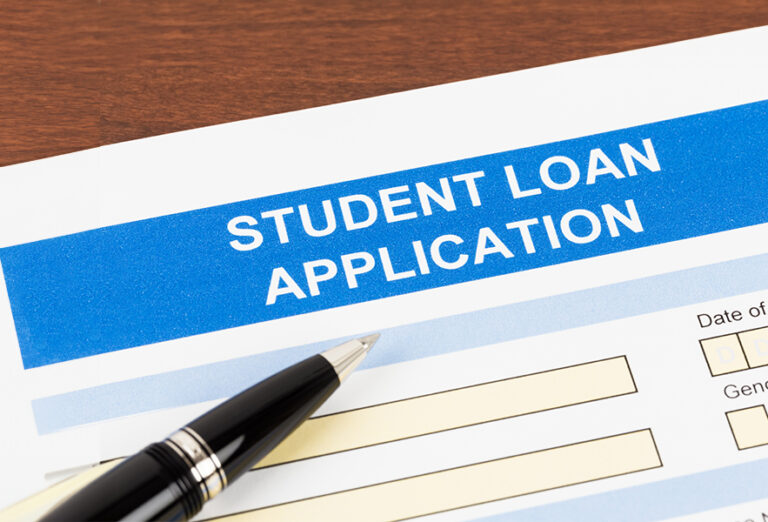What are the differences between federal and private student loans?
Please rotate your device for the best experience.
Transcript
Federal vs. Private Student Loans
Interactive Video
[A laptop with the FAFSA login page on the screen.]
[A young woman with a confused expression on her face.]
Narrator: If you plan to take out a student loan, the options can be confusing. Which would be best for you, a federal or private loan? [Young woman holding both hands up appearing indecisive. “federal loan” appears over one hand, and “private loan” appears over the other.]
[A federal building icon and a state building icon with a line creating separation between them.]
Federal loans are normally the first choice for student loans for four primary reasons [The state building disappears]. Most students are eligible for them. There is no credit check. You don’t need a cosigner. They normally offer lower interest rates.
[On screen text]:
- most students eligible
- no credit check
- no cosigner needed
- lower interest rates
[A federal building icon labeled “federal loan 1st.” A state building icon labeled “private loan 2nd.”]
The majority of students use federal student loans first and then apply for private loans if they have a remaining need for funds.
[A laptop with the FAFSA login page on the screen. A young woman holding a computer against her chest with one arm and pointing up with the other arm, to a speech bubble that says, “Don’t forget!”.]
Don’t forget: If you want to be eligible for federal student loans (or any financial aid), you need to complete the FAFSA.
[The U.S. Department of Education building.]
The Department of Education is your lender for federal student loans. [A pile of cash appears.]
The terms and conditions of federal student loans are set by law. And these loans offer fixed interest rates and income-defined repayment plans. You are not required to start repaying until you graduate, leave school, or reduce your status to less than half-time.
There are four types of federal loans. Select each loan type to learn more.
[On screen text]: Loan types. Select each loan type.
Card 1
Front: Direct Subsidized Loans
Back:
- undergraduate students only
- need-based loans
- no interest payments while in school
- best federal student loan interest rate
Direct Subsidized Loans, also called “sub loans,” are awarded to eligible lower income undergraduate students. Students are not required to pay interest while they are in school, and these loans carry the lowest interest rate for federal student loans.
Card 2
Front: Direct Unsubsidized Loans
Back:
- undergraduate, graduate, and professional students
- not need-based
- pay interest while in school
- higher interest rate than sub loan
Direct Unsubsidized Loans, also called “unsub loans,” are available to undergraduate, graduate, and professional students. Eligibility is not based on financial need. With these loans, you must pay interest while you are attending school, and the loans carry a slightly higher interest rate than sub loans.
Card 3
Front: Direct PLUS Loans
Back:
- graduate/professional students
- parents/guardians of dependent undergraduate students
- not need-based
- credit check required
- optional loan to meet unmet need
Direct PLUS Loans are loans made to graduate or professional students and parents of dependent undergraduate students. These are not need-based loans. A credit check is required for all applicants. Applicants with low credit scores might need to meet additional requirements to apply. These loans are generally taken to secure money for any unmet financial need for school.
Card 4
Front: Direct Consolidated Loans
Back:
- federal student loans combine to one single loan
- one loan servicer
Direct Consolidation Loans allow you to combine all your federal student loans into a single loan with one loan servicer.
[State building icon, labeled “Private Loan.”
In contrast, private loans are held by banks, credit unions, other financial institutions, state organizations, and schools. [Lines appear connecting the state building to the following words and phrases: “banks,” “credit unions,” “financial institutions,” “state organizations," and “schools.”]
[State building icon labeled “Private Loan.”]
Each private loan has its own loan eligibility requirements, application process, and terms and conditions.
[On screen text]:
- loan eligibility requirements
- application process
- terms and conditions
[A credit union loan application.]
Interest rates can be fixed or variable, typically based on your credit score. Students usually need a cosigner. Some private loans require repayment to begin while you’re still in school, and some might have prepayment penalties.
[On screen text]:
- fixed or variable
- potential cosigner
- repayment while in school
- potential penalties
[A straight road named “federal loan” beside a winding road named “private loan.”]
Private student loans are usually the more expensive option over federal student loans; however, they can be a good option if you qualify for a low interest rate or can pay back the loan quickly. [The two-road image is replaced with an image of one road labeled “private loan.”
[A smiling, confident woman stands with her arms crossed with a thought bubble that says, “I qualified for a low interest rate.”]
[ A smiling, confident man standing with his arms crossed with a thought bubble that says, “I can pay back the loan quickly.”]
[A person leaping over a chasm labeled “private loan.”]
Private loans are commonly used as a last resort to help fill any financial gap.
